Carol Baldwin's Blog, page 51
December 14, 2015
The Hanged Man's Noose: A Glass Dolphin Mystery-- A Review and a Giveaway
Congratulations to Sheri Levy who won LIKE A RIVER on last week's blog. Thanks to many of you who entered this popular giveaway. Ironically, Sheri is the reason for this week's review. Read on!
*********As my faithful blog readers know, I generally read and review middle grade or young adult books, but every now and then an adult book sneaks into my pile. Judy Penz Sheluk, author of The Hanged Man's Noose contacted me because I had reviewed Sheri Levy's book, Seven Days to Goodbye. Judy's book was also published by Barking Rain Press and she was interested in my reviewing her debut mystery.
Good thing I agreed. Now one of you will have a chance to win this entertaining book!
Although my WIP, Half-Truths, has elements of mystery, I've never attempted writing a suspense thriller. And while it's challenging writing a novel from two-points-of-view, the intricacies of the Hanged Man's Noose's plot and the way in which Sheluk wove together a complicated backstory, clues, and red herrings--makes me think that my work is a piece of cake. Or, perhaps, in the case of this Canadian whodunit, a "Treasontini"--blueberry vodka plus triple sec plus blueberry juice--as pictured on the cover.
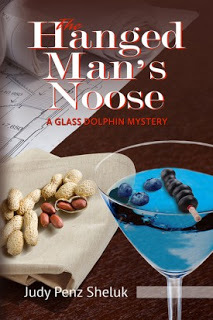
The star of the show is Emily Garland, a journalist who comes to the small town of Lount's Landing to ostensibly start up a small niche magazine. In reality, her boss wants her to find out the scoop on mega-real estate developer, Garrett Stonehaven. Emily is only too happy to bring him to his knees because she thinks he had something to do with her mother's recent mysterious death.
In the process of getting to know the local business proprietors, Emily learns about Garrett Stonehaven's plans to convert an old school to a big box store. His vision for the town's future doesn't sit well with Emily's new friend, Arabella Carpenter, owner of a new antique store who wants to restore the historic main street.
When three people turn up dead in a short period of time Emily's investigative reporting becomes more serious. Her discovery of Stonehaven's past which links him to many of the town residents eventually puts Emily in danger herself.
Sheluk does a good job of characterization both with physical descriptions that match the characters' personalities as well as through their dialogue. Early on Emily meets two of Lount's Landing's townspeople:
My only critique of the story is that there are a lot of characters to keep track of. Occasionally I had to backtrack to remember who a secondary character was. But kudos to Judy Sheluk for her well-plotted debut mystery.
I am offering my gently read copy of Hanged Man's Noose to one of you. To win, please leave me a comment by December 17 with your email address if you are new to my blog. If you become a new follower or share this on social media, I'll enter your name twice.
*********As my faithful blog readers know, I generally read and review middle grade or young adult books, but every now and then an adult book sneaks into my pile. Judy Penz Sheluk, author of The Hanged Man's Noose contacted me because I had reviewed Sheri Levy's book, Seven Days to Goodbye. Judy's book was also published by Barking Rain Press and she was interested in my reviewing her debut mystery.
Good thing I agreed. Now one of you will have a chance to win this entertaining book!
Although my WIP, Half-Truths, has elements of mystery, I've never attempted writing a suspense thriller. And while it's challenging writing a novel from two-points-of-view, the intricacies of the Hanged Man's Noose's plot and the way in which Sheluk wove together a complicated backstory, clues, and red herrings--makes me think that my work is a piece of cake. Or, perhaps, in the case of this Canadian whodunit, a "Treasontini"--blueberry vodka plus triple sec plus blueberry juice--as pictured on the cover.

The star of the show is Emily Garland, a journalist who comes to the small town of Lount's Landing to ostensibly start up a small niche magazine. In reality, her boss wants her to find out the scoop on mega-real estate developer, Garrett Stonehaven. Emily is only too happy to bring him to his knees because she thinks he had something to do with her mother's recent mysterious death.
In the process of getting to know the local business proprietors, Emily learns about Garrett Stonehaven's plans to convert an old school to a big box store. His vision for the town's future doesn't sit well with Emily's new friend, Arabella Carpenter, owner of a new antique store who wants to restore the historic main street.
When three people turn up dead in a short period of time Emily's investigative reporting becomes more serious. Her discovery of Stonehaven's past which links him to many of the town residents eventually puts Emily in danger herself.
Sheluk does a good job of characterization both with physical descriptions that match the characters' personalities as well as through their dialogue. Early on Emily meets two of Lount's Landing's townspeople:
The woman's hair was black as a raven's back and cropped close. With the exception of a pair of diamond stud earrings, she appeared to be decked out in yoga wear from head to toe.
Emily referred to the PDF and pegged her as Chantal Van Schyndle, owner of the Serenity Spa and Yoga Studio. She assume Hockey Jersey was Carter Dixon, owner of Slap Shot, a sporting goods store that Johnny wrote was "barely hanging on." (p.20)Later, Stonehaven and Arabella face off at her store's opening:
"The candlesticks are in the window of the Glass Dolphin for decoration, Mr. Stonehaven. They are not for sale."
"Nonsense, Ms. Carpenter. Everything is for sale at the right price. Everything and anybody. Even you." (p. 47)Emily's desire to find out the truth about her mother's death motivates her to press on--even when her own life is threatened. And in the end, Sheluk neatly ties up the many threads which she wove through the novel.
My only critique of the story is that there are a lot of characters to keep track of. Occasionally I had to backtrack to remember who a secondary character was. But kudos to Judy Sheluk for her well-plotted debut mystery.
I am offering my gently read copy of Hanged Man's Noose to one of you. To win, please leave me a comment by December 17 with your email address if you are new to my blog. If you become a new follower or share this on social media, I'll enter your name twice.

Published on December 14, 2015 05:07
December 7, 2015
You Heard it Here First: Kathy Wiechman's Path to the Grateful American Book Prize- Part II
Congratulations to Monica O' Quinn who won A Handful of Stars by Cynthia Lord. Thanks to so many of you for entering; this was a popular giveaway. And here's another!
Last week you heard how Ohio author Kathy Wiechman, the self-proclaimed "poster child for perseverance" attended workshops and critique groups for years before stepping into the "I'm a published author!" box. Today you'll hear more details about the workshops she's attended, the people who have helped her along the way, and the Grateful American Book Prize.
**********CAROL: Can you tell us more about the Highlights workshops that helped further your career?
KATHY: Shortly after I attended Chautauqua in 1999, the Highlights Foundation began offering smaller, less expensive, workshops at their Boyds Mills location. I told my family not to give me birthday or Christmas gifts anymore, just donate money toward a workshop. My first one was Joy Cowley’s Writing from the Heart in 2001. I was hooked. I went from going every other year to every year to twice a year. I learned about Voice from Patti Gauch, promoting a book from Peter Jacobi, and about the publishing business from numerous experts. I even learned how to load and fire a muzzleloader, when I was researching LIKE A RIVER.
CAROL: Who helped you the most?
KATHY: I took more than half a dozen workshops with Rich Wallace. Not only was he encouraging, but he always seemed to spot what my writing was missing, and I came away with what I needed to move forward. Carolyn Yoder (Calkins Creek Press) saw the early chapters of LIKE A RIVER at a retreat in 2012. She encouraged me to keep going, told me things I could improve, and requested I send it to her when it was finished. I did, and she has been my editor ever since.
CAROL: What were some of Carolyn's suggestions?
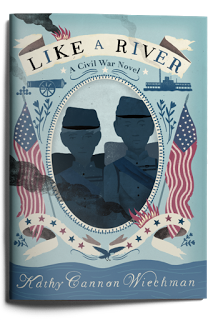 KATHY: Make Leander more likable, flesh out the characters of Crawford and Morgan a bit, and give the two halves of the book more balance.
KATHY: Make Leander more likable, flesh out the characters of Crawford and Morgan a bit, and give the two halves of the book more balance.
CAROL: Why have you chosen not to be agented?
KATHY: When I first began, very few children’s writers had agents. But times have changed, and it can be extremely difficult to get a manuscript in an editor’s hands without an agent. I was researching possible agents at the time I was offered my first contract with Boyds Mills Press. I had an agent friend look over the contract before I signed it, but have never sought one to represent me. I am very fortunate to have been published by Boyds Mills Press, who still accepts unagented manuscripts. If I were a younger writer, I might seek an agent, but for the time being, I don’t feel it necessary.
CAROL: What advice do you wish someone had given you when you first started writing?
KATHY: I wish someone had warned me how long the road to publication can be. I would have traveled it anyway, but it would have been good to know. I wish someone had said, "Don't take rejection personally. Think of it as not being chosen yet." (I heard that after I was already published, but it would have been good to hear during all those struggle years.) I wish someone had said, "Don't be afraid to break the rules of grammar and sentence structure. Have a good reason for breaking them, but don't let them hold you back."
CAROL: Tell us about your experience winning the Grateful American Book Prize. How many books did you compete against? How did you find out about the contest?
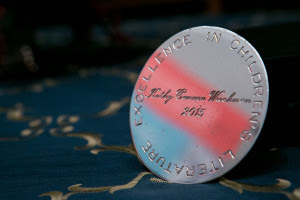 KATHY: I was told there were "more than 140" books competing for the Prize. Last spring, one of the marketing people at Boyds Mills Press told me they were planning to submit LIKE A RIVER for the prize and asked me to write about my research methodology for the submission form. I am incredibly grateful for the support I have gotten from the folks at Boyds Mills Press.
KATHY: I was told there were "more than 140" books competing for the Prize. Last spring, one of the marketing people at Boyds Mills Press told me they were planning to submit LIKE A RIVER for the prize and asked me to write about my research methodology for the submission form. I am incredibly grateful for the support I have gotten from the folks at Boyds Mills Press.
I never dreamed of winning an award. The Grateful American Book Prize is a new award, the brainchild of David Bruce Smith and Dr. Bruce Cole. This inaugural award was for writing about the past in a way that engages young readers in American history, something I have always tried to do with my historical fiction. The judges for the award are people who honored me just by reading LIKE A RIVER; deciding to award me the prize was beyond words. I received the award (an exquisite medal, a fantastic cash prize, and a lifetime membership to the New York Historical Society) at a cocktail party and dinner at Lincoln’s Cottage in Washington, DC.
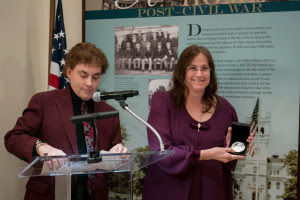 Kathy receiving the Grateful American Book Medal from David Bruce SmithI have always been a devotee of the sixteenth president, and LIKE A RIVER is a Civil War story, so the setting was perfect. Tours of the Cottage are available, and I tried to take one the afternoon of the award ceremony, but I was told the afternoon tours had been cancelled to allow for setting up for “a big event” that evening. My big event! After dinner, I was taken on a personal tour, which ended in the room where Lincoln wrote the Emancipation Proclamation. Heaven indeed for a Lincoln fan and history buff like me!
Kathy receiving the Grateful American Book Medal from David Bruce SmithI have always been a devotee of the sixteenth president, and LIKE A RIVER is a Civil War story, so the setting was perfect. Tours of the Cottage are available, and I tried to take one the afternoon of the award ceremony, but I was told the afternoon tours had been cancelled to allow for setting up for “a big event” that evening. My big event! After dinner, I was taken on a personal tour, which ended in the room where Lincoln wrote the Emancipation Proclamation. Heaven indeed for a Lincoln fan and history buff like me!
CAROL: What’s next?
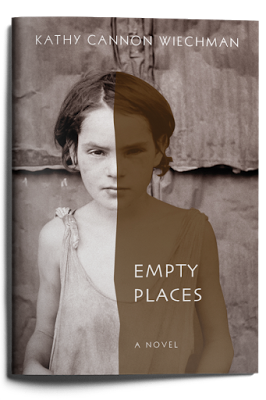 KATHY: My second novel, EMPTYPLACES, is due out in April, 2016. It takes place during the Great Depression in Harlan County, Kentucky, and has a few elements inspired by my husband's family. I am also working on new novels, writing and researching. I waited a long time to reach this stage of my career, and now I am busier than ever, but I enjoy it all, especially meeting with and hearing from the readers who like my book.
KATHY: My second novel, EMPTYPLACES, is due out in April, 2016. It takes place during the Great Depression in Harlan County, Kentucky, and has a few elements inspired by my husband's family. I am also working on new novels, writing and researching. I waited a long time to reach this stage of my career, and now I am busier than ever, but I enjoy it all, especially meeting with and hearing from the readers who like my book.
As I promised a week ago, Boyds Mills Press is providing a copy of LIKE A RIVER to one fortunate blog readers. Leave me a comment (make sure you leave your email address if you're new to my blog) and I'll add your name to the list of entries from last week. (If you left me a comment last week, you can enter twice.) Winner will be drawn on Thursday, December 10 so that you will receive your book in time for the holidays.
*******
Thanks, Kathy, for sharing your journey and wonderful news with us.
Last week you heard how Ohio author Kathy Wiechman, the self-proclaimed "poster child for perseverance" attended workshops and critique groups for years before stepping into the "I'm a published author!" box. Today you'll hear more details about the workshops she's attended, the people who have helped her along the way, and the Grateful American Book Prize.
**********CAROL: Can you tell us more about the Highlights workshops that helped further your career?
KATHY: Shortly after I attended Chautauqua in 1999, the Highlights Foundation began offering smaller, less expensive, workshops at their Boyds Mills location. I told my family not to give me birthday or Christmas gifts anymore, just donate money toward a workshop. My first one was Joy Cowley’s Writing from the Heart in 2001. I was hooked. I went from going every other year to every year to twice a year. I learned about Voice from Patti Gauch, promoting a book from Peter Jacobi, and about the publishing business from numerous experts. I even learned how to load and fire a muzzleloader, when I was researching LIKE A RIVER.
CAROL: Who helped you the most?
KATHY: I took more than half a dozen workshops with Rich Wallace. Not only was he encouraging, but he always seemed to spot what my writing was missing, and I came away with what I needed to move forward. Carolyn Yoder (Calkins Creek Press) saw the early chapters of LIKE A RIVER at a retreat in 2012. She encouraged me to keep going, told me things I could improve, and requested I send it to her when it was finished. I did, and she has been my editor ever since.
CAROL: What were some of Carolyn's suggestions?
 KATHY: Make Leander more likable, flesh out the characters of Crawford and Morgan a bit, and give the two halves of the book more balance.
KATHY: Make Leander more likable, flesh out the characters of Crawford and Morgan a bit, and give the two halves of the book more balance.CAROL: Why have you chosen not to be agented?
KATHY: When I first began, very few children’s writers had agents. But times have changed, and it can be extremely difficult to get a manuscript in an editor’s hands without an agent. I was researching possible agents at the time I was offered my first contract with Boyds Mills Press. I had an agent friend look over the contract before I signed it, but have never sought one to represent me. I am very fortunate to have been published by Boyds Mills Press, who still accepts unagented manuscripts. If I were a younger writer, I might seek an agent, but for the time being, I don’t feel it necessary.
CAROL: What advice do you wish someone had given you when you first started writing?
KATHY: I wish someone had warned me how long the road to publication can be. I would have traveled it anyway, but it would have been good to know. I wish someone had said, "Don't take rejection personally. Think of it as not being chosen yet." (I heard that after I was already published, but it would have been good to hear during all those struggle years.) I wish someone had said, "Don't be afraid to break the rules of grammar and sentence structure. Have a good reason for breaking them, but don't let them hold you back."
CAROL: Tell us about your experience winning the Grateful American Book Prize. How many books did you compete against? How did you find out about the contest?
 KATHY: I was told there were "more than 140" books competing for the Prize. Last spring, one of the marketing people at Boyds Mills Press told me they were planning to submit LIKE A RIVER for the prize and asked me to write about my research methodology for the submission form. I am incredibly grateful for the support I have gotten from the folks at Boyds Mills Press.
KATHY: I was told there were "more than 140" books competing for the Prize. Last spring, one of the marketing people at Boyds Mills Press told me they were planning to submit LIKE A RIVER for the prize and asked me to write about my research methodology for the submission form. I am incredibly grateful for the support I have gotten from the folks at Boyds Mills Press. I never dreamed of winning an award. The Grateful American Book Prize is a new award, the brainchild of David Bruce Smith and Dr. Bruce Cole. This inaugural award was for writing about the past in a way that engages young readers in American history, something I have always tried to do with my historical fiction. The judges for the award are people who honored me just by reading LIKE A RIVER; deciding to award me the prize was beyond words. I received the award (an exquisite medal, a fantastic cash prize, and a lifetime membership to the New York Historical Society) at a cocktail party and dinner at Lincoln’s Cottage in Washington, DC.
 Kathy receiving the Grateful American Book Medal from David Bruce SmithI have always been a devotee of the sixteenth president, and LIKE A RIVER is a Civil War story, so the setting was perfect. Tours of the Cottage are available, and I tried to take one the afternoon of the award ceremony, but I was told the afternoon tours had been cancelled to allow for setting up for “a big event” that evening. My big event! After dinner, I was taken on a personal tour, which ended in the room where Lincoln wrote the Emancipation Proclamation. Heaven indeed for a Lincoln fan and history buff like me!
Kathy receiving the Grateful American Book Medal from David Bruce SmithI have always been a devotee of the sixteenth president, and LIKE A RIVER is a Civil War story, so the setting was perfect. Tours of the Cottage are available, and I tried to take one the afternoon of the award ceremony, but I was told the afternoon tours had been cancelled to allow for setting up for “a big event” that evening. My big event! After dinner, I was taken on a personal tour, which ended in the room where Lincoln wrote the Emancipation Proclamation. Heaven indeed for a Lincoln fan and history buff like me! CAROL: What’s next?
 KATHY: My second novel, EMPTYPLACES, is due out in April, 2016. It takes place during the Great Depression in Harlan County, Kentucky, and has a few elements inspired by my husband's family. I am also working on new novels, writing and researching. I waited a long time to reach this stage of my career, and now I am busier than ever, but I enjoy it all, especially meeting with and hearing from the readers who like my book.
KATHY: My second novel, EMPTYPLACES, is due out in April, 2016. It takes place during the Great Depression in Harlan County, Kentucky, and has a few elements inspired by my husband's family. I am also working on new novels, writing and researching. I waited a long time to reach this stage of my career, and now I am busier than ever, but I enjoy it all, especially meeting with and hearing from the readers who like my book.As I promised a week ago, Boyds Mills Press is providing a copy of LIKE A RIVER to one fortunate blog readers. Leave me a comment (make sure you leave your email address if you're new to my blog) and I'll add your name to the list of entries from last week. (If you left me a comment last week, you can enter twice.) Winner will be drawn on Thursday, December 10 so that you will receive your book in time for the holidays.
*******
Thanks, Kathy, for sharing your journey and wonderful news with us.

Published on December 07, 2015 07:24
December 2, 2015
A Handful of Stars: A Review and Audio Book Giveaway!
I think I can honestly say that I've never read a Cynthia Lord book that I haven't enjoyed. From her picture books about a wild and wacky hamster, to her sensitive middle grade book Rules about an autistic boy and his family, Ms. Lord has a way of telling stories that entertain, teach, and delight readers of all ages.
So, when I had the opportunity to review an audio book for Recorded Books and A Handful of Stars was one of the selections, I jumped at the chance.
I wonder if elementary or middle grade teachers asked their students who the protagonist of this story is, who would they choose? Would they pick Tiger Lily, who has lived with her French Canadian grandparents in a small town in Maine ever since her mother's death when she was a young girl? Young readers might (correctly!) identify that Lily's desire to save her beloved dog Lucky's eyesight is a central problem; the conflicts which Lily faces over her dog and being the right kind of friend makes her the protagonist.
Or would they pick Salma, a migrant farm worker in town to pick blueberries for the summer with her family, who not only shows Lily a truth she didn't want to see about Lucky, but also teaches her about art, courage, and what it means to work hard to follow your dreams?
Then again, I can imagine a spunky fourth grader volunteering that the true protagonist is Lucky. Because if he hadn't run away from Lily, she might never have met Salma. He was responsible for bringing the two girls together in an unlikely, but special friendship that is central to this story.
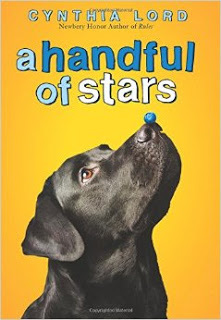
There you go. Now that you have some teasers, here are a few favorite parts:
In order to save money for Lucky's eye operation, Lily sells painted bee houses in her grandparents' store. She stencils on three different patterns and carefully paints each one to realistically resemble blueberries, leaves, or flowers. When Salma volunteers to help, she thinks outside the stencils. Her blueberries are pink or purple and the results shock Lily. When Salma says she loves art because there are different ways of looking at the world and there are no wrong answers, Lily's thinking is challenged.
Proof of the pudding is when Lily goes outside her normal way of painting a bee house and decides to paint a Tiger Lily (first wondering if it a flower or a weed) without using a stencil. When she is done, she admits it's not perfect, but signs her name anyway. This time she created art.
Another favorite plot point is the empathy Lily develops when she learns that her mother, a French Canadian, struggled to feel as if she belonged in the little Maine town. Understanding her mother's history enables Lily to see the obstacles facing Salma as she competes in the local Blueberry Queen pageant.
Finally, she remembers her grandfather's advice to be brave and passes it along to Salma at the pageant: "To do brave things you don't have to be hugely brave. You just have to be a bit braver than you are scared," is so delicious that I have to include it here too.
This would make a great holiday gift for a young girl in your life (ages 8 and up.) I am giving away the audio CD through this issue of Talking Story. Leave a comment here for one chance to win; leave a comment through the newsletter and I'll enter your name twice. Contest is up December 7 so enter now! And make sure you leave your email address if I don't already have it.

So, when I had the opportunity to review an audio book for Recorded Books and A Handful of Stars was one of the selections, I jumped at the chance.
I wonder if elementary or middle grade teachers asked their students who the protagonist of this story is, who would they choose? Would they pick Tiger Lily, who has lived with her French Canadian grandparents in a small town in Maine ever since her mother's death when she was a young girl? Young readers might (correctly!) identify that Lily's desire to save her beloved dog Lucky's eyesight is a central problem; the conflicts which Lily faces over her dog and being the right kind of friend makes her the protagonist.
Or would they pick Salma, a migrant farm worker in town to pick blueberries for the summer with her family, who not only shows Lily a truth she didn't want to see about Lucky, but also teaches her about art, courage, and what it means to work hard to follow your dreams?
Then again, I can imagine a spunky fourth grader volunteering that the true protagonist is Lucky. Because if he hadn't run away from Lily, she might never have met Salma. He was responsible for bringing the two girls together in an unlikely, but special friendship that is central to this story.

There you go. Now that you have some teasers, here are a few favorite parts:
In order to save money for Lucky's eye operation, Lily sells painted bee houses in her grandparents' store. She stencils on three different patterns and carefully paints each one to realistically resemble blueberries, leaves, or flowers. When Salma volunteers to help, she thinks outside the stencils. Her blueberries are pink or purple and the results shock Lily. When Salma says she loves art because there are different ways of looking at the world and there are no wrong answers, Lily's thinking is challenged.
Proof of the pudding is when Lily goes outside her normal way of painting a bee house and decides to paint a Tiger Lily (first wondering if it a flower or a weed) without using a stencil. When she is done, she admits it's not perfect, but signs her name anyway. This time she created art.
Another favorite plot point is the empathy Lily develops when she learns that her mother, a French Canadian, struggled to feel as if she belonged in the little Maine town. Understanding her mother's history enables Lily to see the obstacles facing Salma as she competes in the local Blueberry Queen pageant.
Finally, she remembers her grandfather's advice to be brave and passes it along to Salma at the pageant: "To do brave things you don't have to be hugely brave. You just have to be a bit braver than you are scared," is so delicious that I have to include it here too.
This would make a great holiday gift for a young girl in your life (ages 8 and up.) I am giving away the audio CD through this issue of Talking Story. Leave a comment here for one chance to win; leave a comment through the newsletter and I'll enter your name twice. Contest is up December 7 so enter now! And make sure you leave your email address if I don't already have it.

Published on December 02, 2015 06:04
November 28, 2015
You Heard it Here First: Kathy Wiechman's Path to the Grateful American Book Prize- Part I
To Kathy Wiechman's Ohio, SCBWI, and Facebook friends, this two-part series will come as no surprise. But since many of my readers are from North and South Carolina, I can safely say this will be news to many of you. I hope everyone will enjoy hearing how Kathy, like Jo Hackl, persisted on her path to publication and is now reaping the rewards.
*********I first "met" Kathy through reading and reviewing her debut middle grade novel, Like a River. In our correspondence, she has jokingly referred to herself as the "poster child for perseverance." When I heard she had received the first Grateful American Book Prize, I asked her to share her journey.
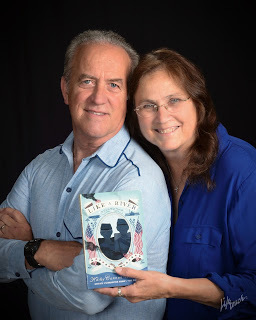 Kathy with her husband Jim
Kathy with her husband Jim
and her award winning debut novel.
CAROL: At one point you said it took you 39 years before you published your first book. What were the highlights of those years? What sacrifices and choices did you make? How did you balance life (raising kids, teaching, etc.) with writing? Most of all, how did you keep going?
KATHY: There is no short answer. It was thirty-nine years between my first novel submission to an editor (1974) and the day I was offered a contract for my novel, LIKE A RIVER (2013). I actually began writing poems when I was five years old.
In the late 1970’s, I took a series of classes from author Stephanie Tolan. She taught me the correct way to submit a manuscript and encouraged me to keep at it. She read a couple versions of an early manuscript and gave me feedback. Having Stephanie tell me I had talent was a definite highlight.
During the 1980’s, I joined SCBWI (which was still SCBW). I wrote, submitted, and received a lot of rejection letters. The slow turn-around from editors taught me how quickly manuscripts became dated. That’s when I combined my love of writing with my other passion, history. Historical fiction was always my favorite read, so why not write it?
As I headed into the 1990’s, I wrote mostly historical fiction. In January, 1990, I joined a critique group in Newport, Kentucky. It has been the source of not only good criticism, but also great friendships. I attended conferences. I craved being with other writers, people who understood the struggle and shared the drive, people I could learn from. In 1996, one of my short stories (MALL MAGIC) won a prize from Children’s Writer. What a highlight that was!
My critique group told me about the Highlights Workshops at Chautauqua. I told them I couldn’t afford it, but I applied for a scholarship. The highlight (from Highlights) that changed my writing life was when I was offered a partial scholarship to attend Chautauqua, 1999. That workshop was fantastic, magical, and my introduction to the Highlights Foundation and their incredible workshops. It was definitely life changing, and an opportunity to make more writer friends.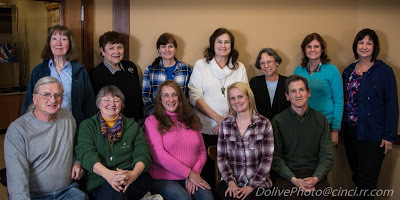 The writers group Kathy has been
The writers group Kathy has been
meeting with for almost 26 years.In 2002, I was invited to join a second critique group in which nearly everyone was published. I felt quite out of my league initially, but they extended a warm welcome. MY FACE, a poem, was published in Ladybugmagazine in 2002. That year, Meadowbrook Press ran another of my poems (NO RETURN) on their website. In 2011, another of my short stories (ONE YEAR AFTER) won a prize from Children’s Writer. In 2012, another poem (IMAGES OF 9/11) was published in an anthology from a small press that no longer exists, and in 2013, ONE YEAR AFTER won a prize from the Center 4 Writing Excellence. In the context of writing novels, these may seem like small victories, but they were confidence-building. And a victory is a victory.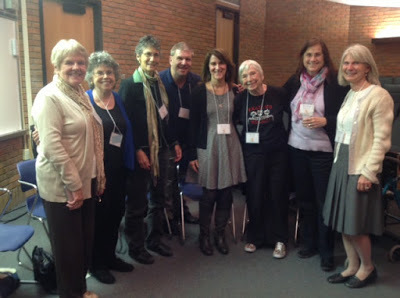 Kathy's second critique group which she joined in 2002.When I was writing that first novel I submitted in 1974, I was expecting my third child. (In 1977, I added a fourth.) I worked in part-time sales in those days to help make ends meet. Money was tight, but I learned how to be frugal. I taught beginner French and Creative Writing. I tutored Language Arts and helped prepare eighth graders to take their high school entrance exams.
Kathy's second critique group which she joined in 2002.When I was writing that first novel I submitted in 1974, I was expecting my third child. (In 1977, I added a fourth.) I worked in part-time sales in those days to help make ends meet. Money was tight, but I learned how to be frugal. I taught beginner French and Creative Writing. I tutored Language Arts and helped prepare eighth graders to take their high school entrance exams.
We couldn’t afford expensive vacations, so we went to places where we had friends or family to stay with. We took short trips to nearby locations. We visited Hodgenville, KY (where Abraham Lincoln was born), Shaker Village (KY), Mammoth Cave (KY), Conner Prairie (IN) and much more. My kids might disagree, but I never felt those trips to be sacrifices. They were family time and experiences that fueled my historical interests.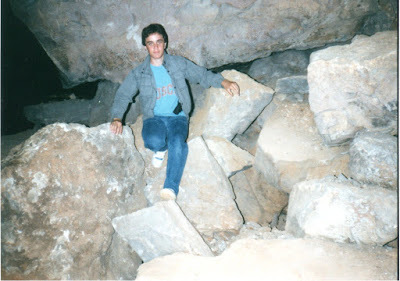 Toby Wiechman, 1989, exploring Mammoth CaveI wrote whenever I could snatch a bit of time. When my kids played outside in the yard, I sat at the picnic table and wrote. When they played games in the family room, I worked at my desk in the corner. I also wrote late into the night after everyone was asleep and the house was quiet. I often stayed up until 4:00AM. I was younger then and could manage on less sleep. You might say I sacrificed housekeeping, and I was much too willing to skip that.
Toby Wiechman, 1989, exploring Mammoth CaveI wrote whenever I could snatch a bit of time. When my kids played outside in the yard, I sat at the picnic table and wrote. When they played games in the family room, I worked at my desk in the corner. I also wrote late into the night after everyone was asleep and the house was quiet. I often stayed up until 4:00AM. I was younger then and could manage on less sleep. You might say I sacrificed housekeeping, and I was much too willing to skip that.
What kept me going was my passion for words and stories. I truly love writing! The person who made it possible for me to keep going was my wonderful husband, who bore the financial burden for all those years. He was also always ready for a road trip so I could do research. He took an interest in all the places I needed to go.
In short, the highlights were the writing itself, small victories, workshops, family trips, and making friends.
**********
I hope you'll come back on Monday, December 7 to read about the people in the industry who helped Kathy, her thoughts about receiving the Grateful American book prize, and her next book, Empty Places . After her next post I'll give away a copy of Like a River. If you leave a comment on both posts (with your email address if you don't think I have it) I'll enter your name twice. Share it on your social media of choice (and tag me!) and I'll enter your name accordingly.
*********I first "met" Kathy through reading and reviewing her debut middle grade novel, Like a River. In our correspondence, she has jokingly referred to herself as the "poster child for perseverance." When I heard she had received the first Grateful American Book Prize, I asked her to share her journey.
 Kathy with her husband Jim
Kathy with her husband Jimand her award winning debut novel.
CAROL: At one point you said it took you 39 years before you published your first book. What were the highlights of those years? What sacrifices and choices did you make? How did you balance life (raising kids, teaching, etc.) with writing? Most of all, how did you keep going?
KATHY: There is no short answer. It was thirty-nine years between my first novel submission to an editor (1974) and the day I was offered a contract for my novel, LIKE A RIVER (2013). I actually began writing poems when I was five years old.
In the late 1970’s, I took a series of classes from author Stephanie Tolan. She taught me the correct way to submit a manuscript and encouraged me to keep at it. She read a couple versions of an early manuscript and gave me feedback. Having Stephanie tell me I had talent was a definite highlight.
During the 1980’s, I joined SCBWI (which was still SCBW). I wrote, submitted, and received a lot of rejection letters. The slow turn-around from editors taught me how quickly manuscripts became dated. That’s when I combined my love of writing with my other passion, history. Historical fiction was always my favorite read, so why not write it?
As I headed into the 1990’s, I wrote mostly historical fiction. In January, 1990, I joined a critique group in Newport, Kentucky. It has been the source of not only good criticism, but also great friendships. I attended conferences. I craved being with other writers, people who understood the struggle and shared the drive, people I could learn from. In 1996, one of my short stories (MALL MAGIC) won a prize from Children’s Writer. What a highlight that was!
My critique group told me about the Highlights Workshops at Chautauqua. I told them I couldn’t afford it, but I applied for a scholarship. The highlight (from Highlights) that changed my writing life was when I was offered a partial scholarship to attend Chautauqua, 1999. That workshop was fantastic, magical, and my introduction to the Highlights Foundation and their incredible workshops. It was definitely life changing, and an opportunity to make more writer friends.
 The writers group Kathy has been
The writers group Kathy has been meeting with for almost 26 years.In 2002, I was invited to join a second critique group in which nearly everyone was published. I felt quite out of my league initially, but they extended a warm welcome. MY FACE, a poem, was published in Ladybugmagazine in 2002. That year, Meadowbrook Press ran another of my poems (NO RETURN) on their website. In 2011, another of my short stories (ONE YEAR AFTER) won a prize from Children’s Writer. In 2012, another poem (IMAGES OF 9/11) was published in an anthology from a small press that no longer exists, and in 2013, ONE YEAR AFTER won a prize from the Center 4 Writing Excellence. In the context of writing novels, these may seem like small victories, but they were confidence-building. And a victory is a victory.
 Kathy's second critique group which she joined in 2002.When I was writing that first novel I submitted in 1974, I was expecting my third child. (In 1977, I added a fourth.) I worked in part-time sales in those days to help make ends meet. Money was tight, but I learned how to be frugal. I taught beginner French and Creative Writing. I tutored Language Arts and helped prepare eighth graders to take their high school entrance exams.
Kathy's second critique group which she joined in 2002.When I was writing that first novel I submitted in 1974, I was expecting my third child. (In 1977, I added a fourth.) I worked in part-time sales in those days to help make ends meet. Money was tight, but I learned how to be frugal. I taught beginner French and Creative Writing. I tutored Language Arts and helped prepare eighth graders to take their high school entrance exams.We couldn’t afford expensive vacations, so we went to places where we had friends or family to stay with. We took short trips to nearby locations. We visited Hodgenville, KY (where Abraham Lincoln was born), Shaker Village (KY), Mammoth Cave (KY), Conner Prairie (IN) and much more. My kids might disagree, but I never felt those trips to be sacrifices. They were family time and experiences that fueled my historical interests.
 Toby Wiechman, 1989, exploring Mammoth CaveI wrote whenever I could snatch a bit of time. When my kids played outside in the yard, I sat at the picnic table and wrote. When they played games in the family room, I worked at my desk in the corner. I also wrote late into the night after everyone was asleep and the house was quiet. I often stayed up until 4:00AM. I was younger then and could manage on less sleep. You might say I sacrificed housekeeping, and I was much too willing to skip that.
Toby Wiechman, 1989, exploring Mammoth CaveI wrote whenever I could snatch a bit of time. When my kids played outside in the yard, I sat at the picnic table and wrote. When they played games in the family room, I worked at my desk in the corner. I also wrote late into the night after everyone was asleep and the house was quiet. I often stayed up until 4:00AM. I was younger then and could manage on less sleep. You might say I sacrificed housekeeping, and I was much too willing to skip that.What kept me going was my passion for words and stories. I truly love writing! The person who made it possible for me to keep going was my wonderful husband, who bore the financial burden for all those years. He was also always ready for a road trip so I could do research. He took an interest in all the places I needed to go.
In short, the highlights were the writing itself, small victories, workshops, family trips, and making friends.
**********
I hope you'll come back on Monday, December 7 to read about the people in the industry who helped Kathy, her thoughts about receiving the Grateful American book prize, and her next book, Empty Places . After her next post I'll give away a copy of Like a River. If you leave a comment on both posts (with your email address if you don't think I have it) I'll enter your name twice. Share it on your social media of choice (and tag me!) and I'll enter your name accordingly.

Published on November 28, 2015 09:30
You Heard it Here First: Kathy Weichman's Path to the Grateful American Book Prize- Part I
To Kathy Weichman's Ohio, SCBWI, and Facebook friends, this two-part series will come as no surprise. But since many of my readers are from North and South Carolina, I can safely say this will be news to many of you. I hope everyone will enjoy hearing how Kathy, like Jo Hackl, persisted on her path to publication and is now reaping the rewards.
*********I first "met" Kathy through reading and reviewing her debut middle grade novel, Like a River. In our correspondence, she has jokingly referred to herself as the "poster child for perseverance." When I heard she had received the first Grateful American Book Prize, I asked her to share her journey.
 Kathy with her husband Jim
Kathy with her husband Jim
and her award winning debut novel.
CAROL: At one point you said it took you 39 years before you published your first book. What were the highlights of those years? What sacrifices and choices did you make? How did you balance life (raising kids, teaching, etc.) with writing? Most of all, how did you keep going?
KATHY: There is no short answer. It was thirty-nine years between my first novel submission to an editor (1974) and the day I was offered a contract for my novel, LIKE A RIVER (2013). I actually began writing poems when I was five years old.
In the late 1970’s, I took a series of classes from author Stephanie Tolan. She taught me the correct way to submit a manuscript and encouraged me to keep at it. She read a couple versions of an early manuscript and gave me feedback. Having Stephanie tell me I had talent was a definite highlight.
During the 1980’s, I joined SCBWI (which was still SCBW). I wrote, submitted, and received a lot of rejection letters. The slow turn-around from editors taught me how quickly manuscripts became dated. That’s when I combined my love of writing with my other passion, history. Historical fiction was always my favorite read, so why not write it?
As I headed into the 1990’s, I wrote mostly historical fiction. In January, 1990, I joined a critique group in Newport, Kentucky. It has been the source of not only good criticism, but also great friendships. I attended conferences. I craved being with other writers, people who understood the struggle and shared the drive, people I could learn from. In 1996, one of my short stories (MALL MAGIC) won a prize from Children’s Writer. What a highlight that was!
My critique group told me about the Highlights Workshops at Chautauqua. I told them I couldn’t afford it, but I applied for a scholarship. The highlight (from Highlights) that changed my writing life was when I was offered a partial scholarship to attend Chautauqua, 1999. That workshop was fantastic, magical, and my introduction to the Highlights Foundation and their incredible workshops. It was definitely life changing, and an opportunity to make more writer friends. The writers group Kathy has been
The writers group Kathy has been
meeting with for almost 26 years.In 2002, I was invited to join a second critique group in which nearly everyone was published. I felt quite out of my league initially, but they extended a warm welcome. MY FACE, a poem, was published in Ladybugmagazine in 2002. That year, Meadowbrook Press ran another of my poems (NO RETURN) on their website. In 2011, another of my short stories (ONE YEAR AFTER) won a prize from Children’s Writer. In 2012, another poem (IMAGES OF 9/11) was published in an anthology from a small press that no longer exists, and in 2013, ONE YEAR AFTER won a prize from the Center 4 Writing Excellence. In the context of writing novels, these may seem like small victories, but they were confidence-building. And a victory is a victory. Kathy's second critique group which she joined in 2002.When I was writing that first novel I submitted in 1974, I was expecting my third child. (In 1977, I added a fourth.) I worked in part-time sales in those days to help make ends meet. Money was tight, but I learned how to be frugal. I taught beginner French and Creative Writing. I tutored Language Arts and helped prepare eighth graders to take their high school entrance exams.
Kathy's second critique group which she joined in 2002.When I was writing that first novel I submitted in 1974, I was expecting my third child. (In 1977, I added a fourth.) I worked in part-time sales in those days to help make ends meet. Money was tight, but I learned how to be frugal. I taught beginner French and Creative Writing. I tutored Language Arts and helped prepare eighth graders to take their high school entrance exams.
We couldn’t afford expensive vacations, so we went to places where we had friends or family to stay with. We took short trips to nearby locations. We visited Hodgenville, KY (where Abraham Lincoln was born), Shaker Village (KY), Mammoth Cave (KY), Conner Prairie (IN) and much more. My kids might disagree, but I never felt those trips to be sacrifices. They were family time and experiences that fueled my historical interests. Toby Weichman, 1989, exploring Mammoth CaveI wrote whenever I could snatch a bit of time. When my kids played outside in the yard, I sat at the picnic table and wrote. When they played games in the family room, I worked at my desk in the corner. I also wrote late into the night after everyone was asleep and the house was quiet. I often stayed up until 4:00AM. I was younger then and could manage on less sleep. You might say I sacrificed housekeeping, and I was much too willing to skip that.
Toby Weichman, 1989, exploring Mammoth CaveI wrote whenever I could snatch a bit of time. When my kids played outside in the yard, I sat at the picnic table and wrote. When they played games in the family room, I worked at my desk in the corner. I also wrote late into the night after everyone was asleep and the house was quiet. I often stayed up until 4:00AM. I was younger then and could manage on less sleep. You might say I sacrificed housekeeping, and I was much too willing to skip that.
What kept me going was my passion for words and stories. I truly love writing! The person who made it possible for me to keep going was my wonderful husband, who bore the financial burden for all those years. He was also always ready for a road trip so I could do research. He took an interest in all the places I needed to go.
In short, the highlights were the writing itself, small victories, workshops, family trips, and making friends.
**********
I hope you'll come back on Monday, December 7 to read about the people in the industry who helped Kathy, her thoughts about receiving the Grateful American book prize, and her next book, Empty Places . After her next post I'll give away a copy of Like a River. If you leave a comment on both posts I'll enter your name twice. Share it on your social media of choice (and tag me!) I'll enter your name accordingly.
*********I first "met" Kathy through reading and reviewing her debut middle grade novel, Like a River. In our correspondence, she has jokingly referred to herself as the "poster child for perseverance." When I heard she had received the first Grateful American Book Prize, I asked her to share her journey.
 Kathy with her husband Jim
Kathy with her husband Jimand her award winning debut novel.
CAROL: At one point you said it took you 39 years before you published your first book. What were the highlights of those years? What sacrifices and choices did you make? How did you balance life (raising kids, teaching, etc.) with writing? Most of all, how did you keep going?
KATHY: There is no short answer. It was thirty-nine years between my first novel submission to an editor (1974) and the day I was offered a contract for my novel, LIKE A RIVER (2013). I actually began writing poems when I was five years old.
In the late 1970’s, I took a series of classes from author Stephanie Tolan. She taught me the correct way to submit a manuscript and encouraged me to keep at it. She read a couple versions of an early manuscript and gave me feedback. Having Stephanie tell me I had talent was a definite highlight.
During the 1980’s, I joined SCBWI (which was still SCBW). I wrote, submitted, and received a lot of rejection letters. The slow turn-around from editors taught me how quickly manuscripts became dated. That’s when I combined my love of writing with my other passion, history. Historical fiction was always my favorite read, so why not write it?
As I headed into the 1990’s, I wrote mostly historical fiction. In January, 1990, I joined a critique group in Newport, Kentucky. It has been the source of not only good criticism, but also great friendships. I attended conferences. I craved being with other writers, people who understood the struggle and shared the drive, people I could learn from. In 1996, one of my short stories (MALL MAGIC) won a prize from Children’s Writer. What a highlight that was!
My critique group told me about the Highlights Workshops at Chautauqua. I told them I couldn’t afford it, but I applied for a scholarship. The highlight (from Highlights) that changed my writing life was when I was offered a partial scholarship to attend Chautauqua, 1999. That workshop was fantastic, magical, and my introduction to the Highlights Foundation and their incredible workshops. It was definitely life changing, and an opportunity to make more writer friends.
 The writers group Kathy has been
The writers group Kathy has been meeting with for almost 26 years.In 2002, I was invited to join a second critique group in which nearly everyone was published. I felt quite out of my league initially, but they extended a warm welcome. MY FACE, a poem, was published in Ladybugmagazine in 2002. That year, Meadowbrook Press ran another of my poems (NO RETURN) on their website. In 2011, another of my short stories (ONE YEAR AFTER) won a prize from Children’s Writer. In 2012, another poem (IMAGES OF 9/11) was published in an anthology from a small press that no longer exists, and in 2013, ONE YEAR AFTER won a prize from the Center 4 Writing Excellence. In the context of writing novels, these may seem like small victories, but they were confidence-building. And a victory is a victory.
 Kathy's second critique group which she joined in 2002.When I was writing that first novel I submitted in 1974, I was expecting my third child. (In 1977, I added a fourth.) I worked in part-time sales in those days to help make ends meet. Money was tight, but I learned how to be frugal. I taught beginner French and Creative Writing. I tutored Language Arts and helped prepare eighth graders to take their high school entrance exams.
Kathy's second critique group which she joined in 2002.When I was writing that first novel I submitted in 1974, I was expecting my third child. (In 1977, I added a fourth.) I worked in part-time sales in those days to help make ends meet. Money was tight, but I learned how to be frugal. I taught beginner French and Creative Writing. I tutored Language Arts and helped prepare eighth graders to take their high school entrance exams.We couldn’t afford expensive vacations, so we went to places where we had friends or family to stay with. We took short trips to nearby locations. We visited Hodgenville, KY (where Abraham Lincoln was born), Shaker Village (KY), Mammoth Cave (KY), Conner Prairie (IN) and much more. My kids might disagree, but I never felt those trips to be sacrifices. They were family time and experiences that fueled my historical interests.
 Toby Weichman, 1989, exploring Mammoth CaveI wrote whenever I could snatch a bit of time. When my kids played outside in the yard, I sat at the picnic table and wrote. When they played games in the family room, I worked at my desk in the corner. I also wrote late into the night after everyone was asleep and the house was quiet. I often stayed up until 4:00AM. I was younger then and could manage on less sleep. You might say I sacrificed housekeeping, and I was much too willing to skip that.
Toby Weichman, 1989, exploring Mammoth CaveI wrote whenever I could snatch a bit of time. When my kids played outside in the yard, I sat at the picnic table and wrote. When they played games in the family room, I worked at my desk in the corner. I also wrote late into the night after everyone was asleep and the house was quiet. I often stayed up until 4:00AM. I was younger then and could manage on less sleep. You might say I sacrificed housekeeping, and I was much too willing to skip that.What kept me going was my passion for words and stories. I truly love writing! The person who made it possible for me to keep going was my wonderful husband, who bore the financial burden for all those years. He was also always ready for a road trip so I could do research. He took an interest in all the places I needed to go.
In short, the highlights were the writing itself, small victories, workshops, family trips, and making friends.
**********
I hope you'll come back on Monday, December 7 to read about the people in the industry who helped Kathy, her thoughts about receiving the Grateful American book prize, and her next book, Empty Places . After her next post I'll give away a copy of Like a River. If you leave a comment on both posts I'll enter your name twice. Share it on your social media of choice (and tag me!) I'll enter your name accordingly.

Published on November 28, 2015 09:30
November 23, 2015
You Heard it Here First: Jo Hackl's Path to Publication - Part II
My apologies if you received an email on Saturday evening with a link to an old blog post--blogger error! Rory's Promise was given away 5 months ago. I'm sorry for the confusion.
Last week Jo Hackl, long-time member of SCBWI-Carolinas, shared the pitch and background of her debut novel, Smack Dab in the Middle of Maybe. This week you'll hear more about working with her agent, Tracey Adams of Adams Literary; finding a publisher; and what she wished she knew before she started her writing journey.
****** Carol: Did Tracey suggest editorial revisions either before or after she acquired the manuscript?
Jo: Tracey suggested editorial revisions before taking me on as a client. I’m very fortunate to have the benefit of her keen perspective and insight and every one of her comments has made the manuscript stronger.
Carol: How long did it take before SMACK DAB found a home? Did Shana Corey suggest many changes? Was the title yours or something you came up with together?
Jo: It took years for SMACK DAB to find the perfect home with Shana Corey at Random House Children’s Books. It was absolutely worth the wait. During that time, I believe I’ve continued to grow as a writer. I’ve taken more classes and workshops. I started a website, www.outdoorosity.org, devoted to providing inspiration and information about the outdoors, and I wrote articles on that site about outdoor experiences. I wrote a young adult novel and am almost through the first draft of a middle grade manuscript. I also continued thinking about SMACK DAB, revising it, and brainstorming on ways to make it stronger.
I greatly admire Shana Corey’s work and was enthusiastic about the opportunity to work with her. Shana suggested changes that I believe will make the story stronger and I’m looking forward to digging into the revision process.
For the title, Tracey, Shana and I brainstormed from a list of around one hundred possibilities. Brainstorming titles is the fun part!
Carol: I’ve often wondered how you balanced being a lawyer, mother, and writer. Any hints on how you have made this juggling act work?
Jo: I think it helps to have a sense of humor, to be curious, not to expect perfection, and to surround yourself with creative, positive people. My family is incredibly supportive. My husband has done more than his share of car-pool duty while I was away at conferences, critique group meetings or on a writing retreat. Our children offer ideas for things my characters might do next. My family in Mississippi helps me keep track of what is in season and edible in the woods so I can verify my research.
My law firm, Wyche, PA, has a strong tradition of attorneys who serve the community and pursue personal interests in addition to the practice of law. My extremely smart colleagues have kept me on my toes during the 25- plus years that I’ve been with the firm and continue to inspire me by their own examples. Among our attorneys are photographers, writers, singers, and musicians and virtually every attorney serves on a community board. I believe this environment encourages creativity. Jo with some of her creative colleagues from the Wyche law firm.Creating time to write has forced me to be very strategic about how I spend my free time and has probably kept me away from a lot of bad television. To create time to start work on this novel, I carved out time at night, between the time our children were in bed and my chef-husband came home from work. Now that our children are older and more independent, I have much more flexibility in creating time to write.
Jo with some of her creative colleagues from the Wyche law firm.Creating time to write has forced me to be very strategic about how I spend my free time and has probably kept me away from a lot of bad television. To create time to start work on this novel, I carved out time at night, between the time our children were in bed and my chef-husband came home from work. Now that our children are older and more independent, I have much more flexibility in creating time to write.
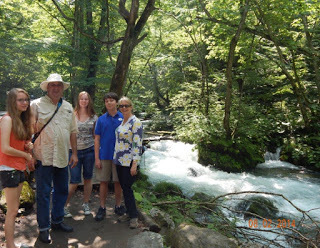 Jo on a family vacation in
Jo on a family vacation in
Japan, 2014Although I need quiet, mostly uninterrupted time to draft, I’ve discovered that I can edit in small chunks. I’ve done a lot of editing through the years sitting in the carpool line. I’ve also found that I can learn something from almost everyone I meet. I keep an idea journal with me at all times and transpose the notes onto a computer file to which I often turn for ideas. I love to listen for rhythm in different regional accents. I’m amazed at the great dialog and character details I’ve been able to pick up at legal conferences, community boards, from neighbors, and in airports.
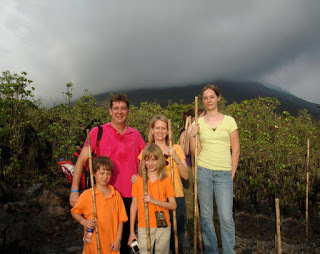 Jo and family in Costa Rica, 2009Carol: How would you encourage others in their search for an agent?
Jo and family in Costa Rica, 2009Carol: How would you encourage others in their search for an agent?
Jo: From the first time I met Tracey Adams, I knew that I wanted to work with her. I was enormously impressed by her experience, talent, warmth, sense of humor, and commitment to excellence in children’s literature. I worked hard on this manuscript and waited until I thought it was ready before I sent it to her. I also had several other shorter pieces and ideas for other projects to demonstrate that I was serious about putting in the work required to be a writer. I would encourage others to first work on writing the best piece they can, let it sit, revise and polish it and make it as strong as it can be, then research potential agents. I would also encourage writers to seek not only a technical match with an agent in terms of experience and genre interest, but someone with whom they believe they will enjoy working over the long term.
Carol: You’ve been very active in SCBWI Carolinas. What role did SCBWI have in your path to publication?
Jo: SCBWI has had a pivotal role in my development as a writer. The workshops and conferences have provided training to help develop technical skills and the wonderfully supportive SCBWI community has been a consistent source of inspiration and encouragement. I’ve made great friends through SCBWI and we cheer each other on in our writing. You’re a great example of that, Carol.
Carol: What advice do you wish someone had given you before you started your novel?
Jo: I think the most important thing I wish someone had advised me before I started working on my first novel is this: “Dig deep and be brave. As you write about your character’s experiences and reactions, recall a time in your life when you felt a similar emotion and try to put into words how it felt to be inside your body at exactly that moment, no matter how awkward or weird. Write the scenes you’re most afraid to write and don’t hold back one bit.”
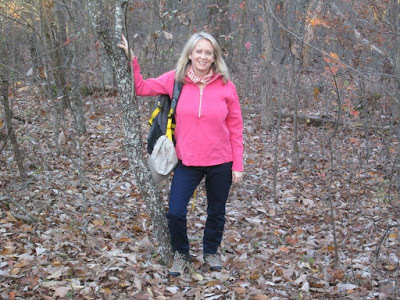 Hiking Paris Mountain, South CarolinaJo Hackl is represented by Tracey Adams of Adams Literary. Jo is also a corporate lawyer with Wyche, P.A. in Greenville, SC, where she is Past President of the Greenville County Bar Association and the recipient of the Richard Riley Award for her pro bono service. She is a past president of Emrys and the founder of
Outdoorosity.org
, which provides a free source of information and inspiration about the outdoors to individuals, families and educators. She lives with her family on the side of a mountain where she writes every day and tries to spend as much time outside as possible.***********Jo has agreed to share some of her research for SMACK DAB including her experiences in an outdoor survival class. But first, I have several book giveaways coming up, another "You Heard it Here First" two part interview (with the winner of the Grateful American Book Prize!), as well as some answers to FAQs about blogging/Facebook/and Twitter from the Carolinas very own Joan Edwards. Stay tuned!
Hiking Paris Mountain, South CarolinaJo Hackl is represented by Tracey Adams of Adams Literary. Jo is also a corporate lawyer with Wyche, P.A. in Greenville, SC, where she is Past President of the Greenville County Bar Association and the recipient of the Richard Riley Award for her pro bono service. She is a past president of Emrys and the founder of
Outdoorosity.org
, which provides a free source of information and inspiration about the outdoors to individuals, families and educators. She lives with her family on the side of a mountain where she writes every day and tries to spend as much time outside as possible.***********Jo has agreed to share some of her research for SMACK DAB including her experiences in an outdoor survival class. But first, I have several book giveaways coming up, another "You Heard it Here First" two part interview (with the winner of the Grateful American Book Prize!), as well as some answers to FAQs about blogging/Facebook/and Twitter from the Carolinas very own Joan Edwards. Stay tuned!

Last week Jo Hackl, long-time member of SCBWI-Carolinas, shared the pitch and background of her debut novel, Smack Dab in the Middle of Maybe. This week you'll hear more about working with her agent, Tracey Adams of Adams Literary; finding a publisher; and what she wished she knew before she started her writing journey.
****** Carol: Did Tracey suggest editorial revisions either before or after she acquired the manuscript?
Jo: Tracey suggested editorial revisions before taking me on as a client. I’m very fortunate to have the benefit of her keen perspective and insight and every one of her comments has made the manuscript stronger.
Carol: How long did it take before SMACK DAB found a home? Did Shana Corey suggest many changes? Was the title yours or something you came up with together?
Jo: It took years for SMACK DAB to find the perfect home with Shana Corey at Random House Children’s Books. It was absolutely worth the wait. During that time, I believe I’ve continued to grow as a writer. I’ve taken more classes and workshops. I started a website, www.outdoorosity.org, devoted to providing inspiration and information about the outdoors, and I wrote articles on that site about outdoor experiences. I wrote a young adult novel and am almost through the first draft of a middle grade manuscript. I also continued thinking about SMACK DAB, revising it, and brainstorming on ways to make it stronger.
I greatly admire Shana Corey’s work and was enthusiastic about the opportunity to work with her. Shana suggested changes that I believe will make the story stronger and I’m looking forward to digging into the revision process.
For the title, Tracey, Shana and I brainstormed from a list of around one hundred possibilities. Brainstorming titles is the fun part!
Carol: I’ve often wondered how you balanced being a lawyer, mother, and writer. Any hints on how you have made this juggling act work?
Jo: I think it helps to have a sense of humor, to be curious, not to expect perfection, and to surround yourself with creative, positive people. My family is incredibly supportive. My husband has done more than his share of car-pool duty while I was away at conferences, critique group meetings or on a writing retreat. Our children offer ideas for things my characters might do next. My family in Mississippi helps me keep track of what is in season and edible in the woods so I can verify my research.
My law firm, Wyche, PA, has a strong tradition of attorneys who serve the community and pursue personal interests in addition to the practice of law. My extremely smart colleagues have kept me on my toes during the 25- plus years that I’ve been with the firm and continue to inspire me by their own examples. Among our attorneys are photographers, writers, singers, and musicians and virtually every attorney serves on a community board. I believe this environment encourages creativity.
 Jo with some of her creative colleagues from the Wyche law firm.Creating time to write has forced me to be very strategic about how I spend my free time and has probably kept me away from a lot of bad television. To create time to start work on this novel, I carved out time at night, between the time our children were in bed and my chef-husband came home from work. Now that our children are older and more independent, I have much more flexibility in creating time to write.
Jo with some of her creative colleagues from the Wyche law firm.Creating time to write has forced me to be very strategic about how I spend my free time and has probably kept me away from a lot of bad television. To create time to start work on this novel, I carved out time at night, between the time our children were in bed and my chef-husband came home from work. Now that our children are older and more independent, I have much more flexibility in creating time to write.  Jo on a family vacation in
Jo on a family vacation inJapan, 2014Although I need quiet, mostly uninterrupted time to draft, I’ve discovered that I can edit in small chunks. I’ve done a lot of editing through the years sitting in the carpool line. I’ve also found that I can learn something from almost everyone I meet. I keep an idea journal with me at all times and transpose the notes onto a computer file to which I often turn for ideas. I love to listen for rhythm in different regional accents. I’m amazed at the great dialog and character details I’ve been able to pick up at legal conferences, community boards, from neighbors, and in airports.
 Jo and family in Costa Rica, 2009Carol: How would you encourage others in their search for an agent?
Jo and family in Costa Rica, 2009Carol: How would you encourage others in their search for an agent?Jo: From the first time I met Tracey Adams, I knew that I wanted to work with her. I was enormously impressed by her experience, talent, warmth, sense of humor, and commitment to excellence in children’s literature. I worked hard on this manuscript and waited until I thought it was ready before I sent it to her. I also had several other shorter pieces and ideas for other projects to demonstrate that I was serious about putting in the work required to be a writer. I would encourage others to first work on writing the best piece they can, let it sit, revise and polish it and make it as strong as it can be, then research potential agents. I would also encourage writers to seek not only a technical match with an agent in terms of experience and genre interest, but someone with whom they believe they will enjoy working over the long term.
Carol: You’ve been very active in SCBWI Carolinas. What role did SCBWI have in your path to publication?
Jo: SCBWI has had a pivotal role in my development as a writer. The workshops and conferences have provided training to help develop technical skills and the wonderfully supportive SCBWI community has been a consistent source of inspiration and encouragement. I’ve made great friends through SCBWI and we cheer each other on in our writing. You’re a great example of that, Carol.
Carol: What advice do you wish someone had given you before you started your novel?
Jo: I think the most important thing I wish someone had advised me before I started working on my first novel is this: “Dig deep and be brave. As you write about your character’s experiences and reactions, recall a time in your life when you felt a similar emotion and try to put into words how it felt to be inside your body at exactly that moment, no matter how awkward or weird. Write the scenes you’re most afraid to write and don’t hold back one bit.”
 Hiking Paris Mountain, South CarolinaJo Hackl is represented by Tracey Adams of Adams Literary. Jo is also a corporate lawyer with Wyche, P.A. in Greenville, SC, where she is Past President of the Greenville County Bar Association and the recipient of the Richard Riley Award for her pro bono service. She is a past president of Emrys and the founder of
Outdoorosity.org
, which provides a free source of information and inspiration about the outdoors to individuals, families and educators. She lives with her family on the side of a mountain where she writes every day and tries to spend as much time outside as possible.***********Jo has agreed to share some of her research for SMACK DAB including her experiences in an outdoor survival class. But first, I have several book giveaways coming up, another "You Heard it Here First" two part interview (with the winner of the Grateful American Book Prize!), as well as some answers to FAQs about blogging/Facebook/and Twitter from the Carolinas very own Joan Edwards. Stay tuned!
Hiking Paris Mountain, South CarolinaJo Hackl is represented by Tracey Adams of Adams Literary. Jo is also a corporate lawyer with Wyche, P.A. in Greenville, SC, where she is Past President of the Greenville County Bar Association and the recipient of the Richard Riley Award for her pro bono service. She is a past president of Emrys and the founder of
Outdoorosity.org
, which provides a free source of information and inspiration about the outdoors to individuals, families and educators. She lives with her family on the side of a mountain where she writes every day and tries to spend as much time outside as possible.***********Jo has agreed to share some of her research for SMACK DAB including her experiences in an outdoor survival class. But first, I have several book giveaways coming up, another "You Heard it Here First" two part interview (with the winner of the Grateful American Book Prize!), as well as some answers to FAQs about blogging/Facebook/and Twitter from the Carolinas very own Joan Edwards. Stay tuned!
Published on November 23, 2015 04:00
November 16, 2015
You Heard it Here First: Jo Hackl's Path to Publication Part I
If you're a member of the SCBWI-Carolinas region, then you probably already know Jo Hackl's cheerful, friendly face. For six years she served as assistant Regional Advisor and was the voice of reassurance and encouragement as the critique coordinator at the annual conference. She and I have been in the region for close to the same length of time, and I've always felt like we were kindred spirits. When I read her response to my questions, discovered her favorite books and that her debut novel includes a cantankerous goat, I understood why. It gives me great pleasure to feature Jo in a two part blog series celebrating Random House's announcement to publish her book in 2017. If you live outside North and South Carolina, you'll just have to come to one of our fantastic conferences to meet Jo and our other fantastic writers!********
Carol: First of all, what was your pitch for Smack Dab in the Middle of Maybe?
Jo: SMACK DAB IN THE MIDDLE OF MAYBE is an outdoor survival meets art mystery story set in a rural Mississippi ghost town. It features Cricket, a budding artist in search of her run-away Mama. The story also includes a Trans-Am driving aunt and fireworks obsessed step-cousins, with a part-time moonshiner and a cantankerous goat thrown in for good measure. I like to think of it as Hatchet meets From the Mixed-up Files of Mrs. Basil E. Frankweiler meets Turtle in Paradise.
Carol: Where did you get the idea for the book? How long did these ideas swim around in your mind before you started writing? Did you wrestle with several different versions before you settled on the one that Random House finally bought?
Jo: I grew up next to a ghost town in rural Mississippi and spent a great deal of time outdoors, exploring the woods. I discovered thick, crumbling sidewalks cutting straight lines through a vine-tangled forest, cement pillars from old home-places laying sideways in the red clay, old garden patches with rambling roses and wisteria gone wild, and mysterious-looking bottles everywhere. The place had so much history that I could practically breathe it.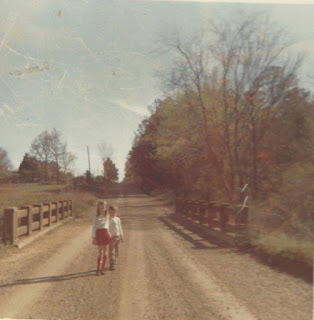 "Walking Bridge" was taken with Jo and her cousin in the gravel road that ran in front of
"Walking Bridge" was taken with Jo and her cousin in the gravel road that ran in front of
their grandparent's home in Kemper County, Mississippi, circa 1970.
I knew that I wanted to use that rich setting in this book. I’m also a fan of contemporary art and wanted to include an art-related mystery element. In brainstorming on the project, I was inspired by the way that From the Mixed-up Files of Mrs. Basil E. Frankweiler (one of my favorite books) placed the main characters in a fascinating setting- the Metropolitan Museum of Art- and introduced them to an art mystery. I wanted to see if I could figure out a way to make the ghost town setting function in similar ways to the museum in The Mixed-up Files- by challenging my main character, sparking her curiosity and imagination, and engaging her in unravelling an art mystery.
I imagined a secret room in the last house standing in the ghost town, its walls, ceiling and floor covered in paintings, with clues to a treasure hidden in the images. To make things more interesting, I added additional clues in a vine-covered sculpture on a pine tree in the woods and on a carving on a dowsing rod found inside the house (because what could be more cool than a rod that can be used to find underground water, treasure, or bodies - take your pick).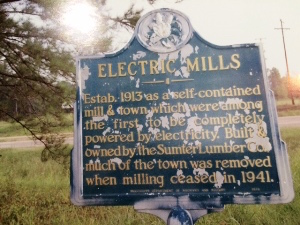 The historic marker for the town of Electric Mills, Mississippi;
The historic marker for the town of Electric Mills, Mississippi;
the ghost town that inspired the setting for Jo's book.No story set in Mississippi would be complete without a cast of lively characters, all ready to speak their mind. I played around with voice and backstory until the characters became real to me. I brainstormed for about a year before I started writing. I also tried several variations and plot structures through the writing and revision process until I found one that seemed right.
Carol: How many drafts did you complete? How long was it from your idea inception to when you started querying agents?
Jo: Oh my! It’s been a long process and I’ve thoroughly enjoyed each stage. I wrote the first draft in five months and spent seven more years revising, refining and polishing. I completed at least nine full drafts (I’ve lost count). I was on at least the fourth draft and several years into the project before I started sending it out.
Carol: What type of help did you receive as you wrote your debut novel?
Jo: I began the first draft of my novel in a class taught by the wonderfully talented Ashley Warlick, who offered a novel writing workshop through Emrys, a local literary arts organization and Ashley has continued to offer wise counsel throughout the project. I attended writing workshops and read books about the craft of writing. I studied and wrote poetry. Emrys and SCBWI conferences and workshops were extremely helpful.
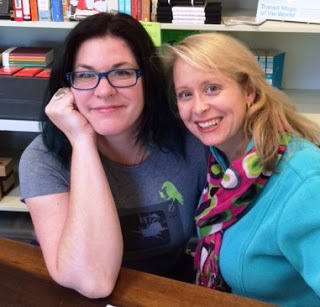 Ashley Warlick and Jo
Ashley Warlick and Jo
The Emrys, SCBWI and outdoor communities are delightfully generous and I had help from many readers, independent editors and critique groups members. I took classes in outdoor survival skills. Naturalists, artists, and people from the mental health community shared their knowledge and answered my questions. Colleagues and friends have been very supportive. And, of course, Tracey Adams’ comments have been invaluable in shaping the manuscript. As soon as I got the word of Random House’s offer of publication (and after I let out a huge whoop and thanked Tracey and my family), I immediately pulled out the ongoing list I’d been keeping of people to thank, to make sure it was updated. It’s a long list! In my case, it really did take a village to write a novel and I was blessed to have this wonderful village to help me on my journey. I look forward to giving back.*******Next week Jo will share how she has balanced a very full life of being a lawyer, mother, and author, as well as the role that SCBWI has played in her life.
Jo Hackl is represented by Tracey Adams of Adams Literary. Jo is also a corporate lawyer with Wyche, P.A. in Greenville, SC, where she is Past President of the Greenville County Bar Association and the recipient of the Richard Riley Award for her pro bono service. She is a past president of Emrys and the founder of Outdoorosity.org , which provides a free source of information and inspiration about the outdoors to individuals, families and educators. She lives with her family on the side of a mountain where she writes every day and tries to spend as much time outside as possible.
Carol: First of all, what was your pitch for Smack Dab in the Middle of Maybe?
Jo: SMACK DAB IN THE MIDDLE OF MAYBE is an outdoor survival meets art mystery story set in a rural Mississippi ghost town. It features Cricket, a budding artist in search of her run-away Mama. The story also includes a Trans-Am driving aunt and fireworks obsessed step-cousins, with a part-time moonshiner and a cantankerous goat thrown in for good measure. I like to think of it as Hatchet meets From the Mixed-up Files of Mrs. Basil E. Frankweiler meets Turtle in Paradise.
Carol: Where did you get the idea for the book? How long did these ideas swim around in your mind before you started writing? Did you wrestle with several different versions before you settled on the one that Random House finally bought?
Jo: I grew up next to a ghost town in rural Mississippi and spent a great deal of time outdoors, exploring the woods. I discovered thick, crumbling sidewalks cutting straight lines through a vine-tangled forest, cement pillars from old home-places laying sideways in the red clay, old garden patches with rambling roses and wisteria gone wild, and mysterious-looking bottles everywhere. The place had so much history that I could practically breathe it.
 "Walking Bridge" was taken with Jo and her cousin in the gravel road that ran in front of
"Walking Bridge" was taken with Jo and her cousin in the gravel road that ran in front of their grandparent's home in Kemper County, Mississippi, circa 1970.
I knew that I wanted to use that rich setting in this book. I’m also a fan of contemporary art and wanted to include an art-related mystery element. In brainstorming on the project, I was inspired by the way that From the Mixed-up Files of Mrs. Basil E. Frankweiler (one of my favorite books) placed the main characters in a fascinating setting- the Metropolitan Museum of Art- and introduced them to an art mystery. I wanted to see if I could figure out a way to make the ghost town setting function in similar ways to the museum in The Mixed-up Files- by challenging my main character, sparking her curiosity and imagination, and engaging her in unravelling an art mystery.
I imagined a secret room in the last house standing in the ghost town, its walls, ceiling and floor covered in paintings, with clues to a treasure hidden in the images. To make things more interesting, I added additional clues in a vine-covered sculpture on a pine tree in the woods and on a carving on a dowsing rod found inside the house (because what could be more cool than a rod that can be used to find underground water, treasure, or bodies - take your pick).
 The historic marker for the town of Electric Mills, Mississippi;
The historic marker for the town of Electric Mills, Mississippi;the ghost town that inspired the setting for Jo's book.No story set in Mississippi would be complete without a cast of lively characters, all ready to speak their mind. I played around with voice and backstory until the characters became real to me. I brainstormed for about a year before I started writing. I also tried several variations and plot structures through the writing and revision process until I found one that seemed right.
Carol: How many drafts did you complete? How long was it from your idea inception to when you started querying agents?
Jo: Oh my! It’s been a long process and I’ve thoroughly enjoyed each stage. I wrote the first draft in five months and spent seven more years revising, refining and polishing. I completed at least nine full drafts (I’ve lost count). I was on at least the fourth draft and several years into the project before I started sending it out.
Carol: What type of help did you receive as you wrote your debut novel?
Jo: I began the first draft of my novel in a class taught by the wonderfully talented Ashley Warlick, who offered a novel writing workshop through Emrys, a local literary arts organization and Ashley has continued to offer wise counsel throughout the project. I attended writing workshops and read books about the craft of writing. I studied and wrote poetry. Emrys and SCBWI conferences and workshops were extremely helpful.
 Ashley Warlick and Jo
Ashley Warlick and Jo The Emrys, SCBWI and outdoor communities are delightfully generous and I had help from many readers, independent editors and critique groups members. I took classes in outdoor survival skills. Naturalists, artists, and people from the mental health community shared their knowledge and answered my questions. Colleagues and friends have been very supportive. And, of course, Tracey Adams’ comments have been invaluable in shaping the manuscript. As soon as I got the word of Random House’s offer of publication (and after I let out a huge whoop and thanked Tracey and my family), I immediately pulled out the ongoing list I’d been keeping of people to thank, to make sure it was updated. It’s a long list! In my case, it really did take a village to write a novel and I was blessed to have this wonderful village to help me on my journey. I look forward to giving back.*******Next week Jo will share how she has balanced a very full life of being a lawyer, mother, and author, as well as the role that SCBWI has played in her life.
Jo Hackl is represented by Tracey Adams of Adams Literary. Jo is also a corporate lawyer with Wyche, P.A. in Greenville, SC, where she is Past President of the Greenville County Bar Association and the recipient of the Richard Riley Award for her pro bono service. She is a past president of Emrys and the founder of Outdoorosity.org , which provides a free source of information and inspiration about the outdoors to individuals, families and educators. She lives with her family on the side of a mountain where she writes every day and tries to spend as much time outside as possible.

Published on November 16, 2015 04:00
November 9, 2015
Mississippi Trial, 1955: A Book Review and a Writing Exercise
I recently submitted the fourth draft of
Half-Truths
to Rebecca Petruck for her critique. In a future blog I'll clue you in on my marching orders for Draft #5, but today I'm sharing a specific part of her feedback about writing scenes. This is a longer blog than normal, so grab your favorite beverage and get ready to learn about a great book and about the writing craft.
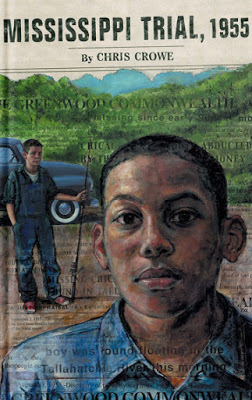
Crowe's debut novel (Penguin Putnam, 2002) is based on the true story of the kidnapping and murder of Emmett Till. Crowe created a believable white protagonist, Hiram Hillburn, whose life is irrevocably changed following Emmett's kidnapping and murder.
As a young child, Hiram spent several years in Greenwood, Mississippi living with his paternal grandparents. He has fond memories of Grampa Hillburn and a town steeped in cotton and Southern traditions. Hiram doesn't understand the deep conflict between his father and grandfather and blames his father for the alienation between the two men.
At 16, Hiram returns to Greenwood after his grandfather suffers a stroke and meets Emmett who is in town visiting his uncle. Hiram reconnects with R.C. Rydell, a boyhood friend who drinks too much and bullies Negroes; and R.C.'s sister Naomi who he likes. R.C. convinces Hiram to go fishing together, and the two meet up with Emmett who is cooling off in the river. R.C. mercilessly bullies Emmett while Hiram stands by helplessly. Afterwards he feels ashamed of himself and later becomes convinced that R.C. was involved in Emmett's death.
This scene follows Hiram reading a newspaper report of Emmett's death:
*******Here are Rebecca's questions:
What did the MC want as he entered the scene? Hiram wants comfort/justice over Emmett's death.
What did he get? He got a "glimpse" into why his father and grandfather don't get along, and a new picture of his grandfather.
How did the author show the external action? Reports the grandfather complaining, shows Hiram arguing.
The internal action/reaction? Hiram's observation that his grandfather was more concerned about negative press than justice is a huge "Aha!" moment. His appreciation for his father initiates a change in his attitude.
How much dialogue is used relative to narrative text? Dialogue and internalization carried this scene; not much narration.
How did the author set the scene?"When I set the paper down." Opens the scene.
End it? With Hiram's new realizations. ********I picked this scene because it was pivotal to Hiram's burgeoning questions of the culture he accepted as a child as well as his new understanding of the tensions between his father and grandfather. The reader sees Hiram's conclusions so that when there is a switch at the end, Crowe has paved the way for a surprise ending.
Rebecca has told me before that I need to go deeper into my character's internal experiences (I guess I'm a slow learner!). But copying out a scene pushed me inside Hiram. I saw his grandfather and father in new ways and found a model for what I needed to work on in Half-Truths.
How about you? Have you ever deeply studied a scene from a novel? If not, I hope you'll try this exercise. If you have, what book did you study? I'd love to hear from you.
And I hope you'll read Mississippi Trial, 1955. You won't regret it; and besides, you need to discover the surprise ending which wraps up this important book so well.

Craft-wise, writing scenes is your weakest element. That’s partly why I asked you to write the slow down scene. You might want to read Make a Scene by Jordan Rosenfeld. For exercises, I suggest choosing a few scenes from three novels and deeply analyze the arc—what did the MC want as she entered the scene? What did she get? How did the author show the external action? The internal action/reaction? How much dialogue is used relative to narrative text? How did the author set the scene? End it?
Then, look at one of your own scenes, and critique it for the elements listed above. Does the scene have an arc? Is there room for the reader to experience what’s happening? Time for the reader to feel what’s happening? How might you deepen the scene? How might you create more tension? Raise the stakes? - Rebecca PetruckThe first novel I chose to study scene making, was the award winning book, Mississippi Trial, 1955 by Chris Crowe. I anticipated learning more about Jim Crow. I gained that, and much more.

Crowe's debut novel (Penguin Putnam, 2002) is based on the true story of the kidnapping and murder of Emmett Till. Crowe created a believable white protagonist, Hiram Hillburn, whose life is irrevocably changed following Emmett's kidnapping and murder.
As a young child, Hiram spent several years in Greenwood, Mississippi living with his paternal grandparents. He has fond memories of Grampa Hillburn and a town steeped in cotton and Southern traditions. Hiram doesn't understand the deep conflict between his father and grandfather and blames his father for the alienation between the two men.
At 16, Hiram returns to Greenwood after his grandfather suffers a stroke and meets Emmett who is in town visiting his uncle. Hiram reconnects with R.C. Rydell, a boyhood friend who drinks too much and bullies Negroes; and R.C.'s sister Naomi who he likes. R.C. convinces Hiram to go fishing together, and the two meet up with Emmett who is cooling off in the river. R.C. mercilessly bullies Emmett while Hiram stands by helplessly. Afterwards he feels ashamed of himself and later becomes convinced that R.C. was involved in Emmett's death.
This scene follows Hiram reading a newspaper report of Emmett's death:
When I put the newspaper down, my hands were shaky and cold. Emmett was dead, murdered. The article said nothing about R.D. Rydell, but I figured the sheriff must still be looking of him. Was R.C. involved in the murder? I knew he was, and I hoped the police would find him--soon.
And what about Naomi? If R.C. skipped town or ended up in jail, she'd be left alone with her dad. I didn't even want to think how much more miserable her life might become in that shack down along the Yazoo.
Grampa interrupted my thoughts when he whistled softly after reading the article. "I can't believe they killed that boy." He rubbed his hand across his face and muttered to himself, "There's going to be hell to pay now." He still looked pale as he folded the paper on his lap, creased it carefully in half, and set it on the table next to his chair. "Hiram, those boys went too far, way too far. For his sake, I sure hope your friend [R.C.] wasn't involved in this mess. I never did think much of R.C. Rydell, but I never took him for a murderer."
"R.C.'s not my friend, Grampa," I reminded him without looking at him. "I told you how he acted."
"Of course he's not your friend. A Hillburn usually has better sense than getting mixed up with people like these." Grampa rapped his knuckles on the folder newspaper. "People all over the United States are hearing about what's happened down here and wondering what kind of uncivilized brutes live in Mississippi. Those peckerwoods who did this are a shame to all of us in the Delta. No self-respecting Southern gentleman would lover himself to of this far."
Grampa's reaction bothered me. He seemed more concerned bout the negative press than about what had happened to Emmett Till.
He kept on complaining. "The radio said that colored boy's mama up in Chicago is blaming everyone in Mississippi for what's happened, said she said, 'The entire state of Mississippi is going to pay for this.' The woman's grief is understandable, Hiram, but she's go tho cause to blame all of us for what a couple redneck peckerwoods did in the middle of the night.
"Before we know it, the NAACP and all those bleeding-heart Northerners are going to use this as another excuses for integration. They're going to come down here and cry about how we treat our Negroes and how we've got to mix the races in our schools. That's what really makes me mad, son: Those ignorant boys have stirred up a hornet's next of trouble."
"But what about Emmett?" I asked. "They killed him. Doesn't that make you mad?"
"Of course those boys went too far. Whatever that colored boy deserved, he didn't deserve getting shot and tossed into the Tallahatchie, that's for sure."
I wanted to yell at Grampa. A boy was murdered just for acting cocky! I wanted to say something, something mean and hard that would knock some sense into him, but I knew nothing I could say would change him, and I had a glimpse into why Dad and Grampa never got along. (p. 123-5)
*******Here are Rebecca's questions:
What did the MC want as he entered the scene? Hiram wants comfort/justice over Emmett's death.
What did he get? He got a "glimpse" into why his father and grandfather don't get along, and a new picture of his grandfather.
How did the author show the external action? Reports the grandfather complaining, shows Hiram arguing.
The internal action/reaction? Hiram's observation that his grandfather was more concerned about negative press than justice is a huge "Aha!" moment. His appreciation for his father initiates a change in his attitude.
How much dialogue is used relative to narrative text? Dialogue and internalization carried this scene; not much narration.
How did the author set the scene?"When I set the paper down." Opens the scene.
End it? With Hiram's new realizations. ********I picked this scene because it was pivotal to Hiram's burgeoning questions of the culture he accepted as a child as well as his new understanding of the tensions between his father and grandfather. The reader sees Hiram's conclusions so that when there is a switch at the end, Crowe has paved the way for a surprise ending.
Rebecca has told me before that I need to go deeper into my character's internal experiences (I guess I'm a slow learner!). But copying out a scene pushed me inside Hiram. I saw his grandfather and father in new ways and found a model for what I needed to work on in Half-Truths.
How about you? Have you ever deeply studied a scene from a novel? If not, I hope you'll try this exercise. If you have, what book did you study? I'd love to hear from you.
And I hope you'll read Mississippi Trial, 1955. You won't regret it; and besides, you need to discover the surprise ending which wraps up this important book so well.

Published on November 09, 2015 04:00
November 2, 2015
How to Get Your Foot Inside of Schools and What to Do Once You’re There: Tips from Alan Gratz
For many authors getting inside schools feels as difficult as finding an agent or publisher. But according to Alan Gratz, an award-winning North Carolina author, it is not only possible, but it’s a great way to build buzz and sell your book.
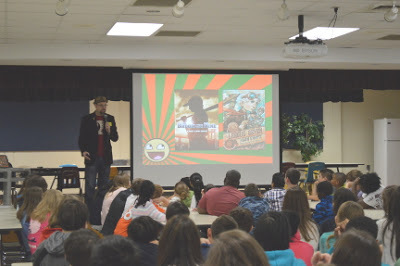 Alan Gratz at Hillcrest Middle School
Alan Gratz at Hillcrest Middle School
Greenville, SC 2015One of the best ways to get started is to hook up with a local bookstore: either an Indie, Barnes and Noble, or Books-a-Million. “Let them know you are interested in going to schools. They usually have relationships with the media specialists and often will create a flier with prices, which can be sent home with students in advance of a visit,” Alan says. But be forewarned: schools that book author visits through a bookstore don’t expect to pay an honorarium to the author. They get an author visit for free in return for the bookstore getting to sell books. Authors can’t afford to do visits like these all the time, financially speaking, but they’re a great way to get that foot in the door and to get experience before booking paid visits.
“At each school visit make sure you ask for the names of other area librarians who might be interested in hosting you and leave extra school visit brochures for all the librarians’ friends. Ask them to help spread the word that you’re interested in visiting more schools.”
In addition, contact your state’s Association of School Librarians and ask if you can appear at their next annual conference. Each state hosts its own conference, usually in the fall or the spring, and most like to invite regional authors, either to present talks or to just sign and sell books. Once you’re invited, bring school visit fliers and hand them out to everyone you meet. Local arts councils also frequently sponsor teaching artists such as writers in the schools.
When Alan arrives at a school, the bookseller either comes with him or has already delivered the pre-sold books. Gratz usually signs pre-ordered books at the school, and invites students who didn’t pre-order a book to join him right after school at the local bookstore, where he has arranged to meet and greet visitors for an hour or two. “I get book sales, the bookstore makes money, and sometimes they even give the schools a cut, or a discount. Everyone's happy! And I didn't have to haul boxes of books and a bag of cash with me.”
When he first started doing school visits in 2006 after his first book, Samurai Shortstop was published, Alan’s honorarium was $500 a day. It quickly went up to $1,000, and as word spread among librarians he was doing upwards of 20 school visits a year. Then the economy took a nosedive. “The money for school visits dried up when the economy tanked, but now that things are recovering, schools seem to have money again.” He’s back to scheduling about twenty school visits a year and his rates are between $1200-$1500 a day.
Alan admits that the key to his success is giving kids a presentation that tells them why his books are FUN TO READ. “Talk about you--who you are, and why you wrote this book. Put some stuff in there about how you write--your process, your experience getting published. But also put in there pictures of your dogs, or your office, or you as a kid, etc. Make it personal. And make it about you and your book.”
What happens after a school visit is equally as important as the visit itself. “When I'm at a school, kids get excited about my books. Then they go home and are excited about them, and sometimes their parents buy them. I see spikes in sales (after the fact) far in excess of the totals the bookstore in town reported, because kids will go home and buy things online, or at other shops. The books circulate in the libraries too, which means there's word of mouth. Writing middle grade, especially, that's the best way to get the word out about a book--through the kids themselves.”********* Alan Gratz’s most recent book is Code of Honor , a YA thriller. He won the 2015 SIBA award for the first book in the The League of Seven trilogy.
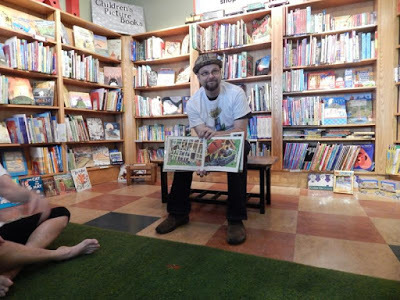 Alan performing a reading
Alan performing a reading
at Malaprop's First Storytime Day, May 2014

 Alan Gratz at Hillcrest Middle School
Alan Gratz at Hillcrest Middle SchoolGreenville, SC 2015One of the best ways to get started is to hook up with a local bookstore: either an Indie, Barnes and Noble, or Books-a-Million. “Let them know you are interested in going to schools. They usually have relationships with the media specialists and often will create a flier with prices, which can be sent home with students in advance of a visit,” Alan says. But be forewarned: schools that book author visits through a bookstore don’t expect to pay an honorarium to the author. They get an author visit for free in return for the bookstore getting to sell books. Authors can’t afford to do visits like these all the time, financially speaking, but they’re a great way to get that foot in the door and to get experience before booking paid visits.
“At each school visit make sure you ask for the names of other area librarians who might be interested in hosting you and leave extra school visit brochures for all the librarians’ friends. Ask them to help spread the word that you’re interested in visiting more schools.”
In addition, contact your state’s Association of School Librarians and ask if you can appear at their next annual conference. Each state hosts its own conference, usually in the fall or the spring, and most like to invite regional authors, either to present talks or to just sign and sell books. Once you’re invited, bring school visit fliers and hand them out to everyone you meet. Local arts councils also frequently sponsor teaching artists such as writers in the schools.
When Alan arrives at a school, the bookseller either comes with him or has already delivered the pre-sold books. Gratz usually signs pre-ordered books at the school, and invites students who didn’t pre-order a book to join him right after school at the local bookstore, where he has arranged to meet and greet visitors for an hour or two. “I get book sales, the bookstore makes money, and sometimes they even give the schools a cut, or a discount. Everyone's happy! And I didn't have to haul boxes of books and a bag of cash with me.”
When he first started doing school visits in 2006 after his first book, Samurai Shortstop was published, Alan’s honorarium was $500 a day. It quickly went up to $1,000, and as word spread among librarians he was doing upwards of 20 school visits a year. Then the economy took a nosedive. “The money for school visits dried up when the economy tanked, but now that things are recovering, schools seem to have money again.” He’s back to scheduling about twenty school visits a year and his rates are between $1200-$1500 a day.
Alan admits that the key to his success is giving kids a presentation that tells them why his books are FUN TO READ. “Talk about you--who you are, and why you wrote this book. Put some stuff in there about how you write--your process, your experience getting published. But also put in there pictures of your dogs, or your office, or you as a kid, etc. Make it personal. And make it about you and your book.”
What happens after a school visit is equally as important as the visit itself. “When I'm at a school, kids get excited about my books. Then they go home and are excited about them, and sometimes their parents buy them. I see spikes in sales (after the fact) far in excess of the totals the bookstore in town reported, because kids will go home and buy things online, or at other shops. The books circulate in the libraries too, which means there's word of mouth. Writing middle grade, especially, that's the best way to get the word out about a book--through the kids themselves.”********* Alan Gratz’s most recent book is Code of Honor , a YA thriller. He won the 2015 SIBA award for the first book in the The League of Seven trilogy.
 Alan performing a reading
Alan performing a readingat Malaprop's First Storytime Day, May 2014

Published on November 02, 2015 04:00
October 26, 2015
Off the Page by Jodi Picoult and Samantha Van Leer
Congratulations to Clara Gillow Clark who won "Diary of a Waitress" off last week's blog.
*******Fans of Between the Lines, a young adult novel that crosses back and forth between fantasy and contemporary fiction, will be happy with the recent release of Off the Page (Delacurte Press, 2015); the companion book which Jodi Picoult wrote in collaboration with her daughter, Samantha Van Leer. [Please note that the quotes I have selected below are from the audio book. Since I often listened while I was driving in the car, I did my best to quickly record favorite lines--when I was stopped at a traffic light or back home!]
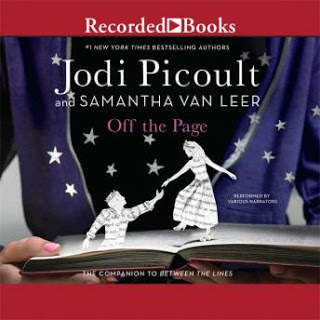 In
Between the Lines
readers meet Delilah, a teenager who has fallen in love with Oliver, a prince in a fairy tale. Through an amazing amount of persistence, romance, and a sprinkling of magic, the two successfully bring Oliver into the real world by having him trade places with Edgar, the son of Jessamine Jacobs (the fictional author of Between the Lines).
In
Between the Lines
readers meet Delilah, a teenager who has fallen in love with Oliver, a prince in a fairy tale. Through an amazing amount of persistence, romance, and a sprinkling of magic, the two successfully bring Oliver into the real world by having him trade places with Edgar, the son of Jessamine Jacobs (the fictional author of Between the Lines).
In this sequel, Oliver discovers some of the pleasures and pitfalls of American life that is far different from anything he has experienced in his fairy tale kingdom. He finds out that refrigerators don't magically restock themselves and real girls, like Delilah, get jealous when other girls at school crush on him. "I've been playing a role ever since I got here," he comments. "[But] I don't know how to be a teenage boy. I only know happily ever after." At one point he acknowledges, "Being in the book was so easy. In the script there were no apologies. I wish someone could turn the pages back."
Delilah on the other hand observes, "Who would dream that having my dreams come true would suck? Now I have to share him with the world." She thought he would be the outsider, but instead, "He is gaining in popularity and I'm the same. The longer he hangs out with the cool kids the less he'll hang out with me." She admits to becoming a jealous monster who she doesn't like.
Edgar, meanwhile, is caught inside Between the Lines. And since Delilah has the only physical/real copy of the book and she is busy keeping up with Oliver, the book never gets opened and he has no idea what is going on in real life. He observes, "Without a reader, the words just sit on the page, waiting to come alive."
I wish I could give the book an unequivocal five star rating, but although it's plotted and written superbly, I can't. When Oliver first comes to Delilah's school, he meets a guy who is gay. When others call him a "fairy" Oliver misunderstands and a scuffle ensues. The guy is head of the LGBT club at school which once explained, Oliver heartily supports. This character makes only a cameo appearance and it appears to me, was thrown in to make the book politically correct. The character offers no substantial contribution to the plot and I find his presence offensive.
There are many incredible lines about books, life, and play-acting in this multilayered and multi-point of view young adult novel. Picoult and Van Leer's collaboration have produced another fast paced romance.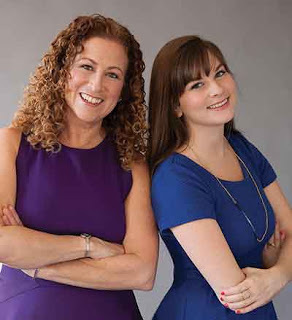 Jodi Picoult and Samantha Van Leer
Jodi Picoult and Samantha Van Leer

*******Fans of Between the Lines, a young adult novel that crosses back and forth between fantasy and contemporary fiction, will be happy with the recent release of Off the Page (Delacurte Press, 2015); the companion book which Jodi Picoult wrote in collaboration with her daughter, Samantha Van Leer. [Please note that the quotes I have selected below are from the audio book. Since I often listened while I was driving in the car, I did my best to quickly record favorite lines--when I was stopped at a traffic light or back home!]
 In
Between the Lines
readers meet Delilah, a teenager who has fallen in love with Oliver, a prince in a fairy tale. Through an amazing amount of persistence, romance, and a sprinkling of magic, the two successfully bring Oliver into the real world by having him trade places with Edgar, the son of Jessamine Jacobs (the fictional author of Between the Lines).
In
Between the Lines
readers meet Delilah, a teenager who has fallen in love with Oliver, a prince in a fairy tale. Through an amazing amount of persistence, romance, and a sprinkling of magic, the two successfully bring Oliver into the real world by having him trade places with Edgar, the son of Jessamine Jacobs (the fictional author of Between the Lines).In this sequel, Oliver discovers some of the pleasures and pitfalls of American life that is far different from anything he has experienced in his fairy tale kingdom. He finds out that refrigerators don't magically restock themselves and real girls, like Delilah, get jealous when other girls at school crush on him. "I've been playing a role ever since I got here," he comments. "[But] I don't know how to be a teenage boy. I only know happily ever after." At one point he acknowledges, "Being in the book was so easy. In the script there were no apologies. I wish someone could turn the pages back."
Delilah on the other hand observes, "Who would dream that having my dreams come true would suck? Now I have to share him with the world." She thought he would be the outsider, but instead, "He is gaining in popularity and I'm the same. The longer he hangs out with the cool kids the less he'll hang out with me." She admits to becoming a jealous monster who she doesn't like.
Edgar, meanwhile, is caught inside Between the Lines. And since Delilah has the only physical/real copy of the book and she is busy keeping up with Oliver, the book never gets opened and he has no idea what is going on in real life. He observes, "Without a reader, the words just sit on the page, waiting to come alive."
I wish I could give the book an unequivocal five star rating, but although it's plotted and written superbly, I can't. When Oliver first comes to Delilah's school, he meets a guy who is gay. When others call him a "fairy" Oliver misunderstands and a scuffle ensues. The guy is head of the LGBT club at school which once explained, Oliver heartily supports. This character makes only a cameo appearance and it appears to me, was thrown in to make the book politically correct. The character offers no substantial contribution to the plot and I find his presence offensive.
There are many incredible lines about books, life, and play-acting in this multilayered and multi-point of view young adult novel. Picoult and Van Leer's collaboration have produced another fast paced romance.
 Jodi Picoult and Samantha Van Leer
Jodi Picoult and Samantha Van Leer
Published on October 26, 2015 04:00



